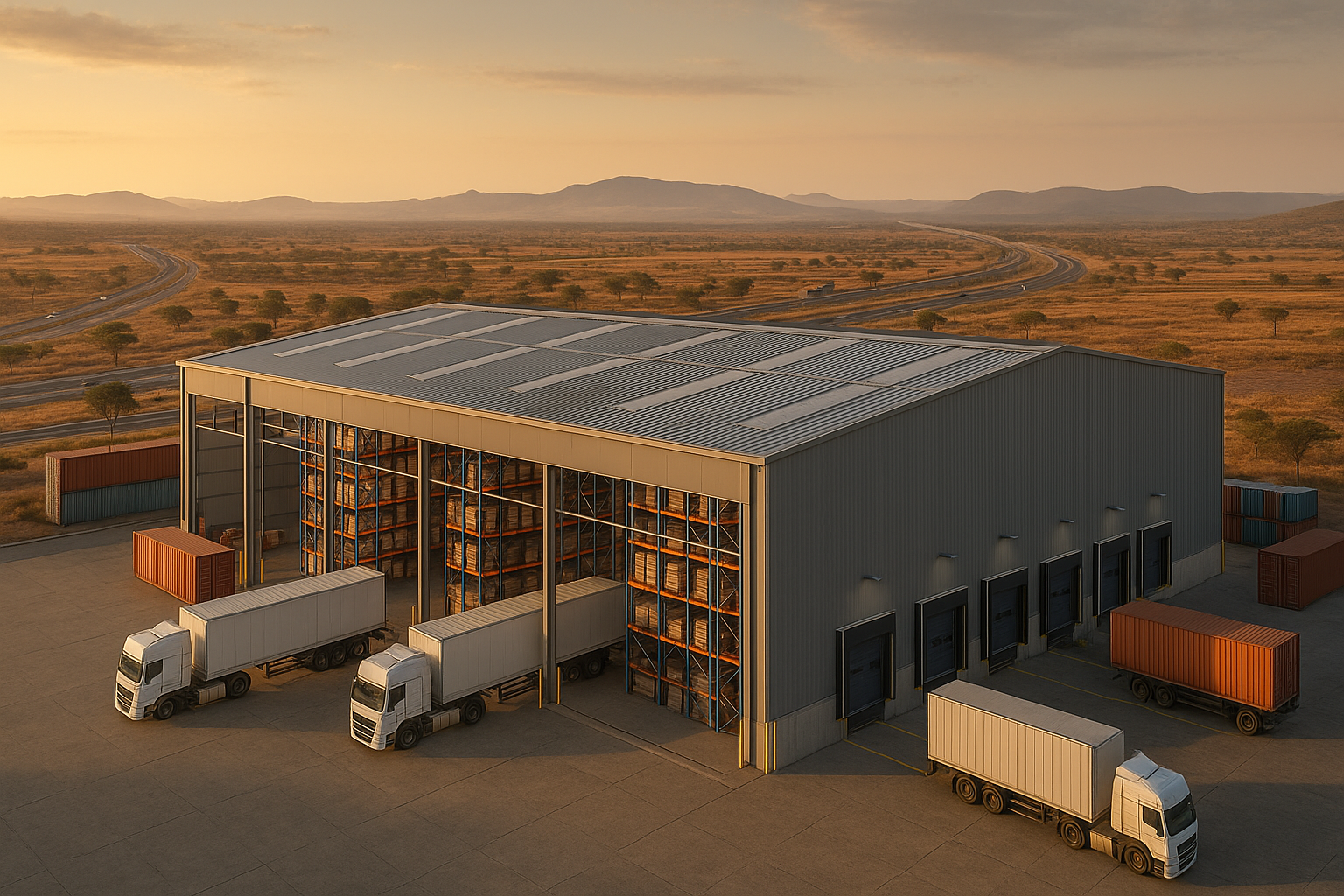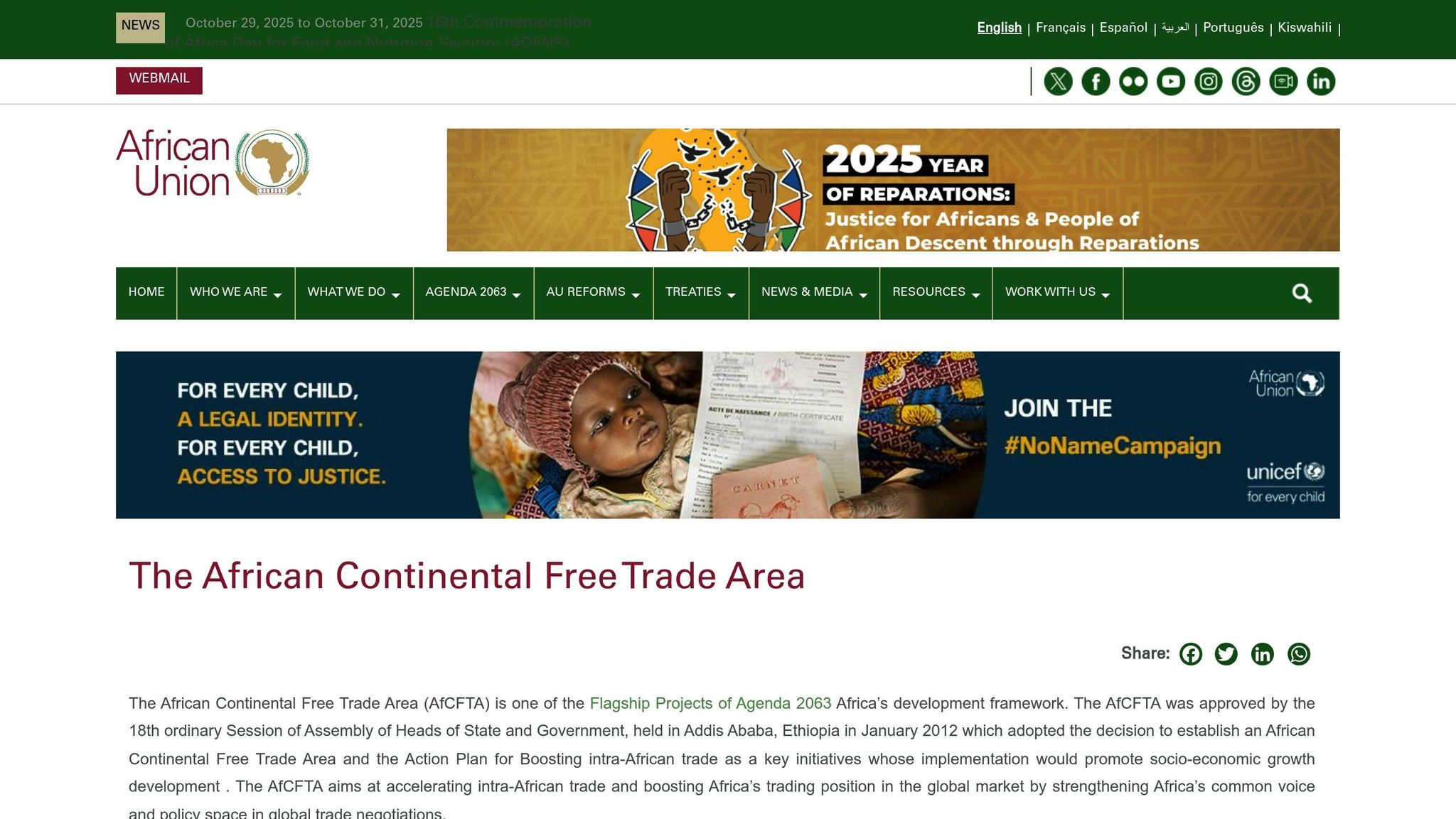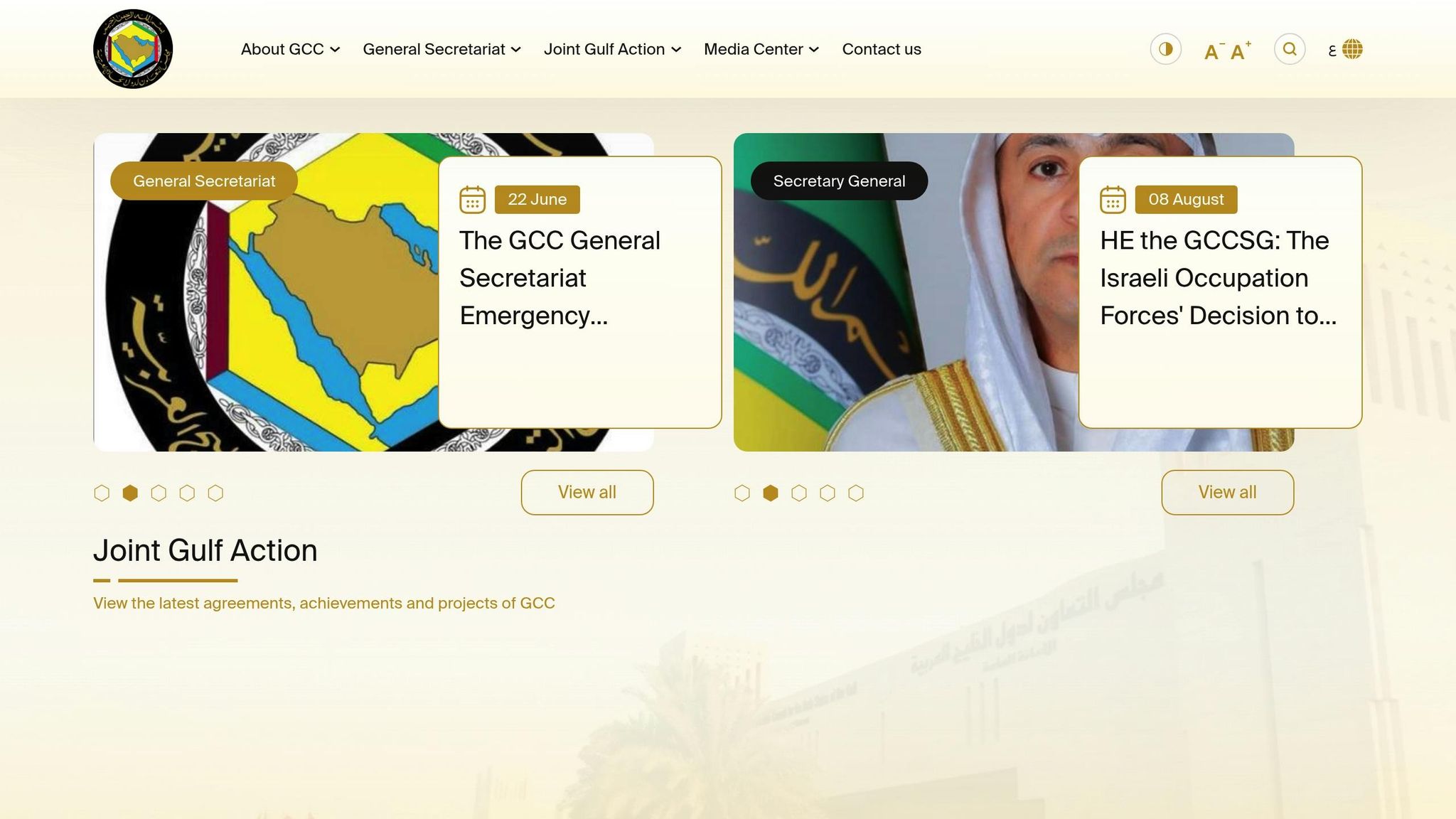Africa’s Quiet Logistics Revolution: How Warehousing is Evolving Across Borders
Explore how Africa's logistics revolution, driven by technology and policy changes, is reshaping warehousing and cross-border trade.

Africa's logistics sector is transforming, driven by technology, infrastructure upgrades, and policy shifts like the African Continental Free Trade Area (AfCFTA). Key changes include modern warehouses with automation, cold storage powered by renewable energy, and digital platforms for real-time inventory tracking. These advancements reduce inefficiencies, enhance cross-border trade, and position Africa as a growing hub for supply chain diversification.
For GCC and MENA stakeholders, Africa's progress offers practical lessons in warehouse design, energy-efficient solutions, and cross-border logistics. Key takeaways include modular infrastructure, renewable energy integration, shared storage facilities, local skill-building, and emergency-ready logistics.
Highlights:
- Infrastructure: Upgraded transport corridors and digital connectivity.
- Technology: IoT, automation, and blockchain for inventory and customs efficiency.
- Cold Storage: Renewable energy-powered systems for agricultural exports.
- Policy: AfCFTA simplifies trade with harmonised customs procedures.
- GCC Relevance: Renewable energy, scalable designs, and resilient supply chains.
Africa's warehousing evolution provides a model for addressing logistics challenges in emerging markets like the GCC and MENA regions.
Key Drivers of Africa's Warehousing Revolution
Africa's warehousing sector is undergoing a major transformation, fuelled by advancements in infrastructure, policy shifts, and strategic investments. Let’s break down these key drivers.
Infrastructure Development Across Borders
Improved transport corridors and enhanced digital connectivity are reshaping Africa’s warehousing landscape. Upgraded transport routes and modernised ports now connect warehouses seamlessly with inland logistics channels. Meanwhile, expanded rail networks and the growth of fibre optic infrastructure enable real-time inventory tracking and more responsive supply chain operations. These physical improvements create a solid foundation for policy changes that aim to make trade even smoother across the continent.
Policy Changes and AfCFTA's Role

Policy reforms are playing a crucial role in driving Africa's warehousing evolution. The African Continental Free Trade Area (AfCFTA) has introduced frameworks that simplify cross-border trade. By harmonising customs procedures and adopting digital trade documentation, the agreement reduces administrative bottlenecks. In addition, regional economic communities are aligning their logistics policies, which supports the creation of a more unified and efficient warehousing environment.
Investment Flows and Regional Collaborations
The surge in investments and public-private partnerships is another key factor behind the modernisation of Africa's warehousing systems. International investors are bringing in advanced technologies, such as automation and climate-controlled storage, to cater to diverse market needs. Funding sources range from sovereign wealth funds to development finance institutions, while South–South partnerships are fostering valuable knowledge-sharing. Together, these efforts are building integrated warehouse systems that can effectively serve regional markets.
Technologies Driving Logistics Changes
Across Africa, the warehousing sector is undergoing a rapid transformation, powered by technology that tackles both operational challenges and regional connectivity hurdles. These innovations are shaping more agile supply chains, cutting costs, and enhancing service quality across borders.
Automation and IoT in Warehousing
With infrastructure upgrades paving the way, automation and IoT are stepping in to redefine efficiency. Automated storage and retrieval systems are becoming staples in major logistics hubs, minimising manual errors and speeding up order processing. Warehouse management systems now integrate with IoT sensors to offer real-time insights into inventory levels, temperature conditions, and equipment performance.
For cross-border shipments, IoT sensors monitor critical factors like temperature and vibration, ensuring products remain intact and meet regulatory standards.
Additionally, radio-frequency identification (RFID) technology is gaining ground in many African warehouses. RFID tags make inventory counts quicker and more accurate, simplifying audits - particularly in facilities managing a wide variety of products.
Digital Platforms for Cross-Border Trade
Beyond automation, digital platforms are playing a pivotal role in smoothing cross-border logistics. Electronic customs clearance systems link warehouses with port authorities and customs offices, cutting down on delays during processing.
Blockchain technology and supply chain visibility platforms are also making waves. By creating tamper-proof records and predicting delays, these tools reduce disputes and speed up customs clearance. Meanwhile, mobile apps with barcode scanning capabilities allow for instant inventory updates, further streamlining operations.
Renewable Energy and Cold Storage Solutions
Solar energy is becoming a key feature in new warehouse developments across Africa, harnessing the region's abundant sunlight to reduce operational costs. Paired with battery storage systems, these setups ensure uninterrupted power, even during grid outages.
Cold storage facilities are also evolving, with energy-efficient solutions that include smart climate controls and multiple temperature zones to accommodate a variety of products. Automated monitoring systems ensure compliance with storage requirements, while thermal energy storage helps manage peak energy demands. These advancements are not only modernising logistics but are also aligned with Africa’s push for efficient and secure cross-border trade.
Cross-Border Logistics: Challenges and Solutions
While technology continues to reshape global trade, cross-border logistics still face hurdles like conflicting regulations, infrastructure gaps, and currency differences.
Economic Corridors and Regional Case Studies
In Africa, economic corridors have become critical for cross-border trade, showing promise through targeted infrastructure improvements and streamlined customs processes. For instance, the Northern Corridor, which links a major port to multiple inland countries, is often highlighted as a benchmark for efficiency. Across the continent, other corridors demonstrate how collaboration between public and private sectors, alongside infrastructure upgrades, can significantly improve logistics. These examples highlight the importance of harmonising regulations across nations to ensure smoother operations.
Managing Regulatory Hurdles
Cross-border logistics operators often grapple with challenges like inconsistent customs procedures, varied documentation requirements, and differing duty structures, all of which can slow down border crossings. Efforts like single customs territories within regional unions have simplified goods movement to some extent. However, standardising requirements - such as certificates of origin under regional trade agreements - remains a work in progress.
To navigate these issues, companies employ compliance officers and adopt pre-clearance systems. Transit bonds and customs escorts provide additional security but can increase planning complexity and costs.
Comparing Logistics Models
Different logistics models address cross-border challenges in unique ways. Here’s a breakdown of how these models function:
| Model | Key Features | Border Processing | Warehousing Requirements | Cost Structure | Best Suited For |
|---|---|---|---|---|---|
| Bonded Warehouses | Duty-suspended storage under customs oversight | Simplified for pre-cleared goods | Secure facilities with compliance systems | Deferred duty payments, improving cash flow | High-value goods and re-export operations |
| Free Trade Zones | Duty-free with fewer regulations | Streamlined entry and exit | Flexible storage, light manufacturing | High initial investment, lower operational fees | Manufacturing and value-added services |
| Third-Party Logistics | Outsourced, resource-sharing operations | Expertise-driven, smoother processes | Shared, scalable facilities | Variable costs with economies of scale | SMEs and seasonal goods |
| Cross-Docking Hubs | Rapid transfer, minimal storage | Fast transit, reduced documentation | Limited storage for high throughput | Lower storage costs, higher handling fees | Time-sensitive goods and consolidated shipments |
For example, bonded warehouses allow importers to delay duty payments until goods reach their final destination, offering better cash flow management. Free trade zones, on the other hand, provide flexibility for operations like light manufacturing but often require a significant upfront investment. Third-party logistics providers are particularly valuable for smaller businesses, leveraging their expertise and economies of scale to offer cost-effective solutions. Meanwhile, cross-docking hubs are ideal for time-sensitive shipments, minimising storage time and expediting delivery.
The best logistics model depends on factors like the type of goods, trade volume, and destination. For instance, perishable items might benefit from cross-docking hubs due to their speed, while manufactured goods may require the controlled environment of bonded warehouses.
Lessons for GCC and MENA Stakeholders

Africa’s recent logistics advancements offer a treasure trove of ideas for GCC and MENA stakeholders facing similar infrastructure and regulatory hurdles. By examining Africa's warehousing evolution, decision-makers in the Gulf region can identify practical strategies to address challenges in land use, storage, and supply chain resilience.
Land Use and Storage Solutions
Africa has showcased creative ways to maximise limited land resources, such as vertical storage systems and multi-purpose facilities. These approaches are particularly relevant for GCC markets, where space constraints and high real estate costs are common challenges.
Another standout lesson is the adoption of solar-powered warehouses, which not only reduce operational costs but also address sustainability concerns. For GCC operators dealing with high cooling demands, this solution offers both financial and environmental benefits. Similarly, hybrid cooling systems that combine renewable energy with backup generators provide consistent temperature control - ideal for facilities in the UAE and Saudi Arabia managing temperature-sensitive goods.
Modular construction techniques, widely used in African markets, demonstrate how storage facilities can be built quickly and expanded in phases as demand grows. This approach minimises upfront costs while maintaining the flexibility to adapt to future needs, an essential consideration for emerging markets with fluctuating demand.
Africa's experiences with public-private partnerships in land acquisition also offer valuable insights. These partnerships show how government support can be harnessed to develop infrastructure while maintaining operational independence, creating shared benefits for broader economic zones.
These storage strategies naturally tie into broader discussions of supply chain resilience.
Approaches to Sovereign Resilience
Africa’s logistics transformation also sheds light on how to strengthen supply chain sovereignty - an area of growing importance for GCC nations. One key takeaway is the emphasis on regional manufacturing capabilities alongside robust storage infrastructure, which reduces reliance on distant supply chains.
Stockpiling initiatives in Africa provide an efficient model for managing essential commodities and medical supplies. By focusing on strategic reserves without tying up excessive capital, GCC countries can enhance supply security.
Other African innovations, such as cross-border storage agreements, offer ways to scale capacity during peak demand. Local training programmes that reduce dependence on external providers further underline the importance of developing homegrown expertise.
To manage geopolitical uncertainties, Africa has developed multiple corridor options for critical supply routes. This redundancy ensures continued operations even if one pathway is disrupted - a vital strategy for regions prone to volatility.
Policies promoting local content requirements, as seen in some African markets, highlight how boosting domestic employment and procurement can simultaneously drive economic growth and improve supply chain resilience.
Lastly, integrating emergency response capabilities into standard warehouse operations is a game-changer. Facilities designed to quickly shift portions of their capacity toward humanitarian supplies or strategic reserves during crises maximise the value of logistics investments while supporting national security goals.
Conclusion: Africa as a Blueprint for Logistics Development
Africa's transformation in warehousing, driven by targeted infrastructure projects and regional cooperation, showcases its potential as a model for emerging markets in the GCC and MENA regions. By focusing on practical, step-by-step solutions, Africa has managed to tackle complex logistics challenges effectively. This approach is especially relevant for regions where large-scale infrastructure projects may face financial or regulatory hurdles.
The continent's emphasis on aligning regional policies has significantly improved cross-border logistics. Its success in developing economic corridors that bridge multiple countries serves as a powerful example of how neighbouring markets can collaborate to enhance logistics instead of competing.
Another key factor is Africa's selective adoption of technology, which addresses specific local needs without overloading operations. For example, using solar energy for cooling systems or IoT tools for inventory tracking has led to real-world improvements without requiring a complete operational overhaul.
What also stands out is Africa's resilience in maintaining supply chains during disruptions. By building flexibility into infrastructure and diversifying operational approaches, African markets have demonstrated how to adapt and thrive in challenging conditions.
Key Takeaways for Decision-Makers
For stakeholders in the GCC and MENA regions, Africa's warehousing evolution offers five actionable lessons that can inform logistics strategies:
- Modular infrastructure development: Africa's success with scalable warehouse designs shows the value of phased growth. This approach allows operators to match capacity with demand, reducing financial risks while maintaining flexibility - an ideal strategy for regions with uncertain demand or limited initial capital.
- Integration of renewable energy: African facilities that use hybrid solar-conventional power systems have cut costs and improved reliability. For GCC markets, where energy costs are high and sustainability is a growing priority, adopting similar systems offers both immediate savings and long-term benefits.
- Cross-border partnerships: Africa's use of shared storage facilities and coordinated transport networks highlights how collaboration can expand market access and share infrastructure costs. This cooperative model could enable smaller GCC markets to tap into larger logistics capabilities.
- Local capability building: By investing in training and knowledge-sharing initiatives, African markets have achieved sustainable results. For MENA regions aiming for supply chain independence, focusing on developing local expertise is crucial.
- Emergency response readiness: Africa's integration of crisis management features into logistics infrastructure has been invaluable during disruptions. GCC stakeholders can adopt this by designing warehouses that can quickly pivot to serve as strategic reserves or humanitarian hubs.
These lessons offer a clear roadmap for creating sustainable and adaptable logistics systems. By focusing on achievable improvements and learning from Africa's experience, GCC and MENA regions can build resilient supply chains that are better equipped to handle future challenges.
FAQs
How does the African Continental Free Trade Area (AfCFTA) improve cross-border trade and optimise warehousing operations in Africa?
The African Continental Free Trade Area (AfCFTA) is making cross-border trade easier by cutting tariffs and reducing non-tariff barriers, simplifying customs processes, and addressing border delays. These steps are helping goods, services, and capital flow more freely between African countries, boosting trade efficiency and encouraging stronger economic ties across the continent.
Another key focus of AfCFTA is improving regional logistics and warehousing infrastructure. By modernising these systems, customs procedures become faster, and storage solutions more effective. This progress is essential for strengthening intra-African trade, building more resilient supply chains, and supporting sustained economic growth throughout the region.
What are the latest technologies transforming warehousing in Africa, and how are they enhancing logistics efficiency?
Technological advancements are reshaping warehousing across Africa, with automation systems such as conveyor belts and automated storage solutions taking centre stage. By the end of 2024, approximately 15% of warehouses had integrated these systems, leading to noticeable improvements in operational efficiency.
On top of that, smart warehouses powered by IoT and AI are transforming how facilities operate. These technologies enhance security, monitor environmental conditions, and boost productivity. For instance, large-scale warehouses equipped with these tools can process goods faster, manage inventory more effectively, and scale operations effortlessly. This wave of innovation is not just streamlining logistics but also contributing to stronger regional trade networks and economic development.
How can the GCC and MENA regions apply Africa's logistics innovations to address infrastructure and regulatory challenges?
The GCC and MENA regions have much to gain by looking at Africa's progress in logistics. For instance, investing in regional infrastructure projects - such as the ambitious GCC railway network - could significantly boost connectivity across borders. Pairing this with digital standardisation for cross-border transactions can make operations smoother and more efficient.
Incorporating new supply chain technologies and encouraging regional collaboration, much like Africa's emphasis on research, development, and technology sharing, could further enhance logistics networks. These steps can address infrastructure gaps, simplify complex regulations, and bolster regional trade. Such efforts align closely with the UAE's vision of economic diversification and building a resilient economy.
